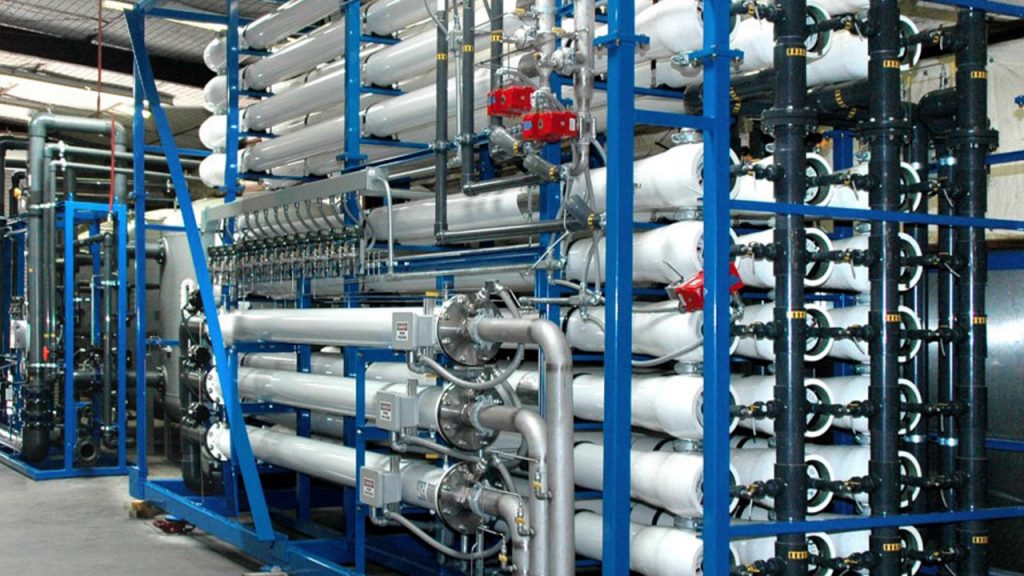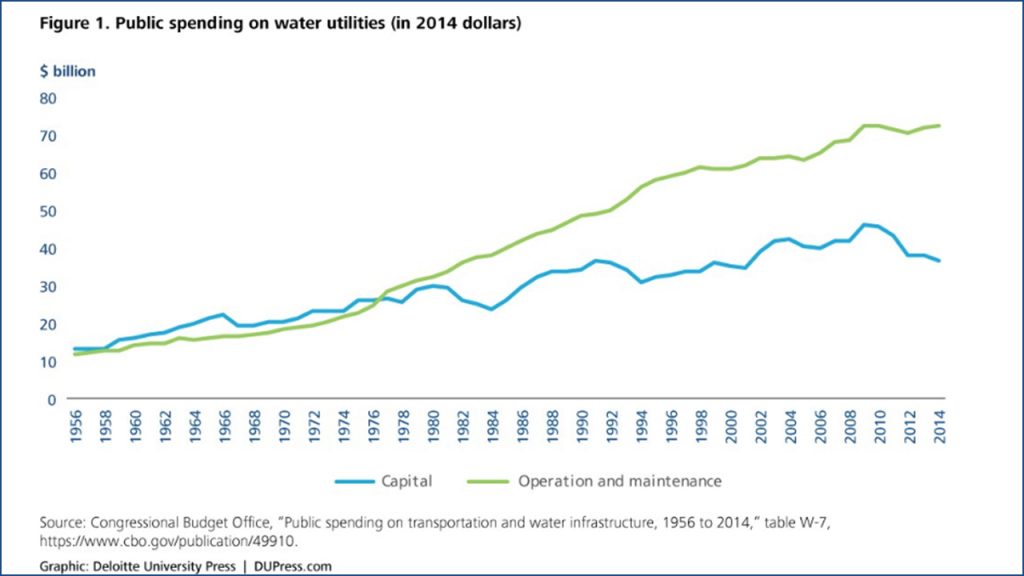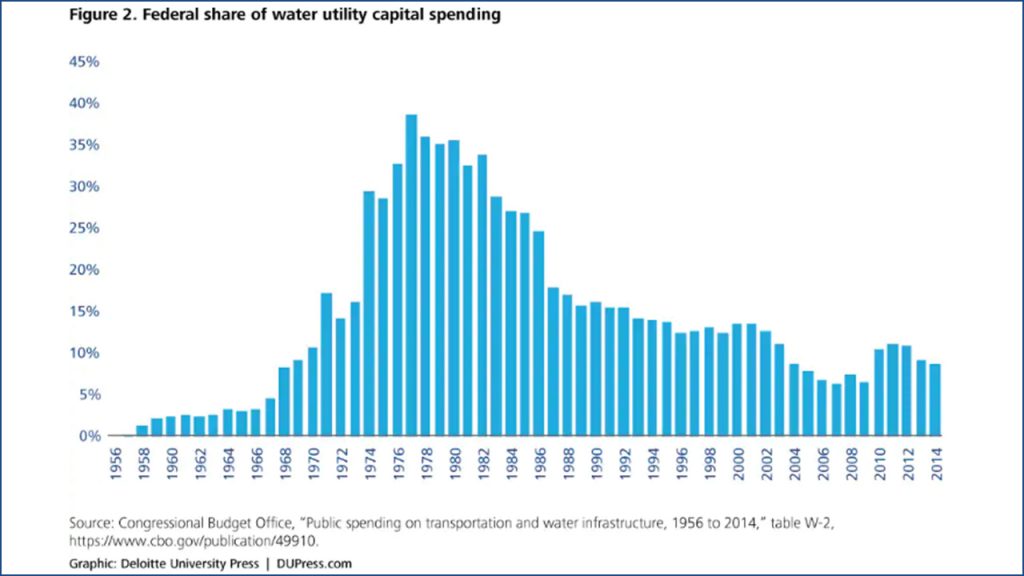Modular Water Systems Help Improve Environment
Proprietary Methods Applied at Point-of-Use Dramatically Improve Hotel Water Quality, Reduce Carbon Footprint and Combat Global Warming

Structural Unsustainability
It’s not a pretty picture!
Right now, we’re living with an archaic form of centralized water treatment and management. Our antiquated centralized utilities represent a major contribution of carbon and nutrient pollution to the environment. Structurally, this is not remediable and has to change.
Meanwhile, a bright light is shining on an alternative system.
Before we cite the environmental advantages and cost savings inherent in an alternative system, we need to understand why there is this trend toward new decentralized or modular water treatment and management vs. the older centralized water management.
Let’s first look at the structural unsustainability of the current centralized system.
Postwar Vision Obsolete
The postwar vision of massive central facilities servicing all users is not only unrealistic, but in light of environmental impacts, it’s no longer feasible and downright dysfunctional.
In short, there is insufficient time to effectively manage air and water pollution impacts created by large utilities in heavily urbanized metropolitan areas that rely upon these utilities.
While governments and the largest water companies are drawn to massive billion-dollar projects, their structure is still primitive, unwieldy and in a word, they’re history!
The only reasonable alternative that can keep up with demand and increased regulation is on-site water treatment and management, which we will demonstrate when we report on our Hotel Case Study below.
The Decentralized Alternative
First, we need to understand that when a decentralized approach to treatment is used, it is far easier to deploy advanced treatment capabilities to effectively remove pollutants, including those that can damage our ecosystem and contribute to global warming.
The fact is that it is much easier to reclaim and reuse this same water for other beneficial purposes. And of course, collection and conveyance issues largely disappear; since the treatment occurs at the point and time of use.
The only water being transported and stored is water already treated, hence it is no longer an environmental issue or burden.
Point of Use Removal of Carbon and Nutrients
By deploying advanced bioreactor systems complemented by advanced filtration processes at a decentralized level (or customer location), we can effectively prevent the formation of methane gas, quickly off-gas nitrogen in a gaseous (harmless) form, and effectively capture and remove phosphorus, for final disposal in a controlled fashion.
When we take this a step further with even more robust water filtration capabilities, we can capture nearly all problematic pollutants (carbon, nitrogen, and phosphorus) where these captured constituents can be properly managed as a resource and otherwise prevented from making their way into the atmosphere and local water systems, or worse into the ocean.
Reducing the Public Utilities Overload
Point-of-use treatment sites, which we will talk about in our Hotel Case Study, substantially lessen water and nutrient burdens on the municipality. Additionally, by reducing this burden, it also helps mitigate the overload problems that these utilities are experiencing.
In conclusion, we can now deploy advanced treatment equipment at the point of use, such as at hotels, so that the local point-of-use contribution of pollution to the common public sewer utility is drastically reduced or eliminated, which in turn reduces the demand placed on the greater public utility, resulting in a net reduction in the water and nutrient footprints on the global environment.
Implementation of Modular Systems
By choosing to treat its own water, a hotel or other business can remove problematic chemical compounds commonly found in most public water supplies, which protects a business’s own water infrastructure and customers, and, at the same time, enables secondary reuse of highly treated wastewater for cooling tower water, landscape water feature replenishment, and where applicable, site irrigation.
These same treatment initiatives also present an opportunity to reduce carbon and nutrients.
Implementation of packaged, decentralized systems can not only permit the reuse of on-site water, thereby reducing overall water demand, but can also provide a level of treatment that will significantly reduce the overall impact a hotel facility will have on the local and global environment.
From the Small to the Very Large
The modular, decentralized solution can be integrated from the small commercial level to very large institutional facilities.
We expect that every new multi-story building erected along urban skylines will soon be equipped for potable water treatment, gray water treatment and blackwater treatment systems, routinely delivered and intelligently controlled like an elevator or HVAC system, so the facility can reuse its consumed water multiple times, while reducing the water and wastewater treatment capacity demands on the local water utility.
This kind of standard is already implied by such enlightened certifications as WELL.
This trend toward decentralized service within a massive existing centralized infrastructure environment could not have been envisioned by water planners even ten years ago. Today, it is a growing reality that offers a practical solution in the nick of time for our cities, and indeed the planet.
The key is to leverage rapidly evolving manufacturing and technology capabilities in new configurations that solve real world problems where they are most effective — at the point of use.
Ultimately, we believe this will drive better health outcomes, economic growth and reduced environmental impacts.

An on-site, advanced purification system built by OriginClear’s Texas subsidiary, Progressive Water Treatment.
This complete refinery water plant system includes Media Filtration, Water Softening, and Reverses Osmosis.
The RO skid pictured here houses three complete 250 GPM RO Systems.
Hospitality Application Ideal for Modular
Recently, the management of a new hotel chain requested a modular water treatment package to provide maximal health, environmental and comfort benefits — Beyond Clean Water™. Nutrient and water management footprints became a sustainability topic of interest.
In this case study, we identify potential benefits in these areas and contrast them with conventional, centralized approaches.
Hotel Case Study
The proposed hotel site was expected to consume on average 30,000 gallons per day (GPD) of potable water. This reflects normal domestic demands such as drinking, bathing, cooking, laundry, spa, and pools. Practical experience indicates that a 90% conversion of potable water to wastewater will occur in such a facility.
With that value in mind, we estimated the carbon and nutrient loads generated in this facility and modeled the overall waste load discharged to the local public sewer or environment.
To better convey this thought process in easily understood terminology, we need to first understand what a hotel wastewater stream might produce for carbon and nutrients.
A Typical Hotel: by the Numbers
A typical hotel domestic wastewater will have an approximate Biological Oxygen Demand (BOD) of 425 mg/L (milligrams per liter); that translates to an approximate biodegradable carbon load concentration of 425 mg/l. Nutrient loads for nitrogen and phosphorus will have concentrations of 50 mg/l and 10 mg/l, respectively.
If a 30,000 GPD domestic potable water consumption has a 90% conversion rate to wastewater, the resulting wastewater demand will be 27,000 GPD, and when we conduct simple mathematical calculations to convert metric concentrations to mass loading, we conclude that a 27,000 GPD hotel wastewater rate will discharge 106.4 pounds (lbs.) of carbon, 12.5 lbs. of nitrogen, and 2.5 lbs. of phosphorus to the public sewer on a daily basis.
This same mass loading will equate to 38,836 lbs. (19.4 tons) of carbon, 4,562 lbs. (2.3 tons) of nitrogen, and 912 lbs. (0.5 tons) of phosphorus imposed upon the local public utility or to the local environment on an annual basis.
Achievable Gains in Carbon Removal
If a modular wastewater treatment process were implemented to reduce the carbon and nutrient load on the local water resource systems, it is entirely possible to sustainably achieve a 99% removal rate for carbon from this same waste stream.
Depending upon the type of process implemented, we can achieve a nutrient removal rate of between 70% to 99% for nitrogen and phosphorus, respectively. These reduction rates would equate to the annual removal of 19.2 tons of carbon, 2.28 tons of nitrogen, and 0.49 tons of phosphorus.
These values are significant in their total mass loading and reflect a tangible reduction in potential harm to the environment.
Dramatic Improvement in Water Quality
Beyond the carbon and nutrient footprint reduction, this same treatment capability will provide the opportunity to recover water that exceeds the most stringent of permit requirements so that the water can be reused for secondary purposes such as cooling towers, landscape water features, and site irrigation.
In warm and arid environments, the majority of the recovered wastewater can be used for site irrigation and cooling water. In more temperate climates with typical annual rainfalls, it is still possible to discharge these same highly treated waters without any fear of impact to the local soil and water resources.
In short, modular water treatment systems can significantly reduce environmental impact, creating opportunities to reduce operating expenses through Insurance Programs (risk mitigation), reduction in water consumption costs, and possible tax incentives for enterprises that desire to implement footprint reduction programs related to water conservation and carbon emissions.
The public’s perception of good stewardship is an additional intangible, but valuable asset, as well.
Applying Proprietary Methods to Point-of-Use Treatment
With a decentralized or modular solution, we can reduce both the water and nutrient footprints (carbon, nitrogen, and phosphorus) in a single package.
By doing this, we have effectively reduced the impact on both the local water district and the local environment.
Our proprietary hybrid treatment method, featuring advanced blackwater treatment followed by advanced clean water processing, can convert the nutrients to less harmful compounds, or even capture them for a beneficial purpose.
Modular vs. Centralized: The Bigger Picture
We have quantified the footprint reduction that can be achieved from adopting a modular on-site system that treats the incoming water and reuses its consumed water multiple times, while at the same time reducing capacity demands on the local water district, and positively affecting the environment.
But there is a bigger picture.
Today, we track sustainability, which was not a topic in the 19th and 20th centuries. But nearly all water treatment is centralized, a model that has dominated for the past hundred years.
Let’s examine how that centralized model is keeping up with modern sustainability concerns.
The State of U.S. Centralized Water Treatment
More than 85% of the U.S. population is served by a few “mega water systems” ─ those with flow greater than 1 million gallons per day (report).
But aging water infrastructure is forcing these utilities to spend more each year. Because capital investment has fallen off, Operation and Maintenance expenses keep rising, with no end in sight
Global water losses, or Non-Revenue Water (NRW) are estimated at 35% of all water supplied. Saving just half of this amount would supply water to an additional 100 million people without further investment. (The Manager’s Non-Revenue Water Handbook, downloadable PDF)
This aging infrastructure is falling badly behind: a 2015 report by the American Water Works Association estimates that the cost of restoring underground pipes will total at least $1 trillion over the next 25 years, without including the cost of constructing new infrastructure or repairing treatment plants.
And government is not helping out: the burden will fall on ratepayers.
An additional problem is that cities are now built-up, and digging for new mains and facilities is lengthy, difficult, costly, and extremely troublesome to businesses and consumers.
And, local community activists can be extremely effective in slowing or even stopping disruptive urban projects.
Finally, shipping dirty water to a central point for treatment violates modern sustainability standards, especially when the system is structurally broken.
Let’s look at the global impact to the environment from centralized systems.
Global Impacts of Centralized Water Management
Collection and Conveyance
Municipal sewage collection and conveyance systems are often in deteriorating condition and contribute to groundwater pollution and air pollution.
- Groundwater pollution occurs when piping systems leak untreated wastewater into the ground, which carries along nutrient pollution that contaminates groundwater and surface water resources.
- Air pollution occurs when sewage collection systems experience biological formation of methane due to anaerobic conditions that exist in all sewers. Methane off-gases into the atmosphere where it contributes to climate change on a far more significant basis than carbon dioxide. (Scientists now recognize that methane gas emissions represent the single largest current contribution to air pollution and climate change).
Beyond that, biological formation of hydrogen sulfide gas in sewers contributes to the formation of sulfuric acid which aggressively attacks and destroys a lot of the concrete materials utilized in modern sewer systems ─ which further compounds and accelerates air and water pollution impacts.
In short, collecting and transporting sewage from point of use to a central site contributes unacceptably to carbon and nutrient loads in the environment.
Central Sewage Treatment
The great majority of the centralized wastewater treatment systems in the US suffer due to age, degraded performance, and ever-increasing demand from industrial and commercial growth.
Sewer utilities that are expected to treat higher hydraulic and organic loads are no longer capable of providing the level of treatment needed to protect the environment.
In addition, the waste that is generated impacts the environment, and ultimately drives climate change. Carbon, nitrogen, and phosphorus loads to the environment all contribute to climate change.
Carbon, mainly in the form of methane, is becoming very problematic, to an even greater extent than carbon dioxide or CO2 alone.
Nutrients in the form of nitrogen and phosphorus readily contribute to algae formation in water bodies which upset natural water chemistries that have existed in a state of balance for millennia.
Algae blooms rapidly contribute to low oxygen concentrations and anaerobic conditions in waterways that then foster the perfect environment for massive releases of microbiologically produced methane gas. This cycle is now becoming readily apparent as engineers and scientist developer a stronger understanding of the complex interactions that take place in the natural world.
Many larger wastewater treatment plants face a daily challenge of maintaining compliance with discharge permits and often violate those same permits. These violations will release a nutrient load to the environment.
While violations may be numerically small on a percentage basis, the actual quantitative discharge on a mass loading basis can be very significant, especially as the size of the facility increases.
When populations suffer water quality problems, they find themselves at the mercy of governmental dysfunction.
The water district for Compton, California was dissolved after it couldn’t resolve chronically tainted tap water. The problem continues.
Centralized Reuse and Recycling
Recycling rates in the United States are stuck at about 1%, while recycling at many existing central facilities in today’s built-up cities is structurally unrealistic.
Imagine trying to recycle water that has flowed from LA’s Beverly Hills to the city’s massive Hyperion plant in El Segundo, by the Santa Monica Bay. There is only one direction the treated sewage can go: into the ocean. There is no infrastructure for sending the water back uphill for reuse.
Regional authorities, such as California’s San Diego County, have to deal with citizen revulsion at the mere concept of ‘toilet to tap’. This tends to add time and trouble to any centralized recycling effort.
Punitive water rates in drought-intensive regions like California are a major incentive for users to reuse their water… and create a business case for self-help water treatment.
Prospect of Fixing Central Utilities
Before we abandon the idea of central utilities, can all this be caught up with massive, Manhattan Project-style efforts?
Florida’s Miami-Dade County is a poster child for the problem (report).
Currently, more than 100,000 sites in the county are on septic tanks. Increased flooding is leading to failure of these disconnected systems, with sewage invasion at the property and street level.
The county has proposed to spend $6 billion to connect these sites to the central sewage system (but independent estimates range as high as $8 billion).
Even assuming funding in a region that is generally tax-opposed, the fact that these sites are so distant from the central facilities means decades of torn-up streets and business discontinuity, with the problem continuing unabated in the meantime.
An Inevitable Trend
The trend is inevitable: as mentioned earlier, public utilities are experiencing rapid declines in available treatment capacity. They can’t easily provide increased customer capacity without major investment in infrastructure upgrades at existing massive regionalized facilities.
Even assuming billions in funding and long-term burdens on the taxpayer, big central upgrades take years of planning and engineering, and years of disruptive construction, assuming no community challenges, which would lead to further cost overruns and delays.
Meanwhile, aging water distribution and wastewater collection systems are leaking precious clean water and harmful untreated wastewater into the local environment, all at a cost to the individual utility customer who ultimately bears the cost, and a growing impact to the environment from methane and nutrient releases.
Case Study: Lessons Learned
So, it is imperative that we learn from such cases as our Hotel Case Study, as we expand modular water treatment throughout the hospitality industry, and beyond to other sectors.
It is clear that by doing so we can significantly reduce operating costs and environmental impact. We also can reduce operating expenses, water consumption costs, and achieve possible tax incentives for enterprises desiring to implement carbon footprint reduction programs related to water conservation and emissions of carbon and far more environmentally destructive elements into our challenged atmosphere.
Written by:
Daniel M. Early, PE
President & Senior Engineer
Modular Water Systems™, an OriginClear® Brand
T. Riggs Eckelberry
Chairman and CEO
OriginClear, Inc.
Thomas Madden
CEO & Chairman
TransMedia Group
June 2019, V8



